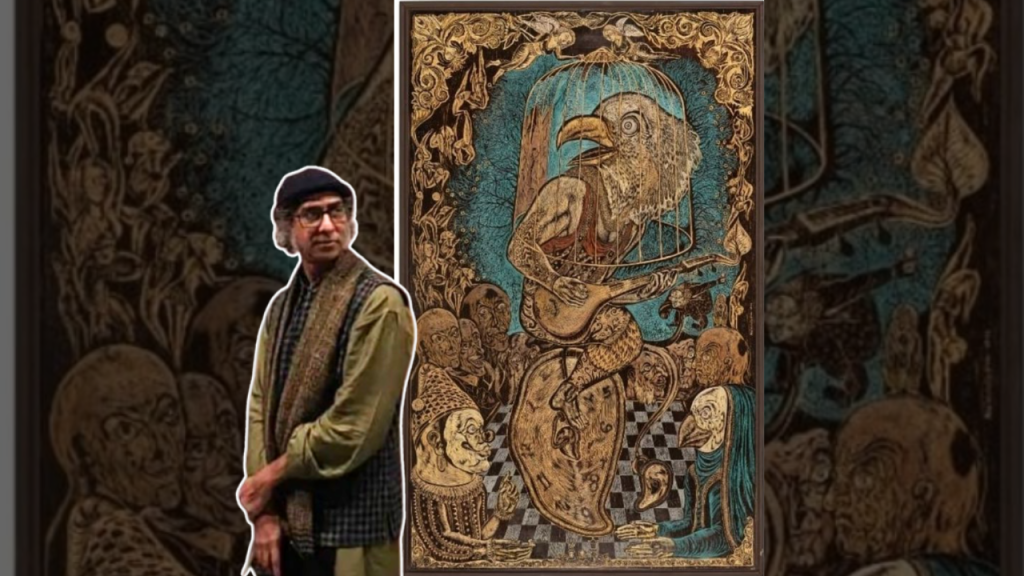Srikanta Paul, whose work plays a phenomenal blend of surrealism, symbolism, and tactile opulence, is currently being showcased at Emami Art Gallery through the exhibition 𝗘𝗸𝗸𝗵𝗮𝗻: Situating the Present. The large-scale woodblock panel (Letterpress Ink on Woodblock Panel of 77.3 x 48.2 in., 2022) invites viewers into a layered investigation into freedom, entrapment and the intricate timing of creativity within contemporary life.

Centered upon the panel is a humanoid figure with the beaked head of bird, who is enclosed (and thereby trapped) within a cage in the form of a giant bird. Immediately, the picture conjures up caged and lost freedom metaphors. Birds, which have historically served as representations of the soul or a type of freedom, are in turn flipped into an emblem of confinement, and one that also implies our deepest desires to break free, to flee are all held back by the invisible boxes we’ve constructed for ourselves—either culturally set, mentally invented or exteriorally introduced. The human with the head of a bird is in a similar state, unable overstep his physical boundaries in the same manner people are bound by their limitations.
Adding to the work’s surreal character is a warped clock that makes up the bottom half of the figure, who sports a bird for a head. This image alludes to Salvador Dalí’s infamous clock representing the melted time in his painting The Persistence of Memory. Paul’s clock that is warped, the time slipping away from him, escaping any concrete meaning. It might represent the ridiculousness of temporal rigidity in comparison to creative life and personal experience. Time is a resource and a thief for an artist. The melting clock here appears to represent that paradox, time moves on for the caged figure but without significant change or development.
Around the central figure are caricature-like figures, characterized by outrageous features and expressions — bemusement, distance, disdain toward the bird-headed woman. They are precursors to society; average people with eyes to see and make judgments, yet rarely take action in others’ agony. Many of these figures wear clown or minstrel masks that accentuate the scene’s surreality and absurdist quality. We are made to wonder to what extent those strangers have any real empathy for this bird, or if indeed they revel in the show of detainer w while casually watching on the sidelines.
The figures stand on a black-and-white checkerboard floor, hinting at dualism — life as game and even perhaps the rather eloquent presence of theatre itself. Oppositional themes traditionally associated with black and white (good vs. evil, freedom vs. confinement, etc.) In this case, the checkerboard can be used to highlight how staged every moment of struggle in life — as real and painful as it is — might be is entirely influenced by an imposed and made-up set of rules.
The thing that elevates Srikanta Paul over anyone else is both his deft use of symbolism and surrealist imagery but also the very materials he uses and how he engages with them. Letterpress ink on woodblock manifests a physical, palpable surface adds texture and dimension to the picture. While not inherently organic the elements implied connect the artwork to the process and manipulation of materials by hand, relating it to a physical/tactile world while addressing abstract, surrealist concerns.
The work of Srikanta Paul featured in 𝗘𝗸𝗸𝗵𝗮𝗻: Situating the Present situates itself as an existential contemplation on freedom, time and the human situation. This artist is the bird-headed figure, contained within a cage yet given an outlet to play music—encapsulated in their own paradox. It represents time in the form of melted clocks, highlighting the absurdity of our beings experiencing life above and beyond its boundaries. The monstrous spectators remind us of society — active or complacent, in this fight for existence. Paul’s process — the tweaking of woodblock, making paper and appearance with amusing materials — really helps reinforce what he dirty works. Ultimately, Paul not only places today into a remarkable context; he delivers a colourful and surreal statement on the point and purpose of being alive. With surrealism, symbolism, and sophisticated technique. Srikanta leads us into a fictitious realm reminiscent of the often-absurd worlds found in life and creativity.

Iftikar Ahmed is a New Delhi-based art writer & researcher.





